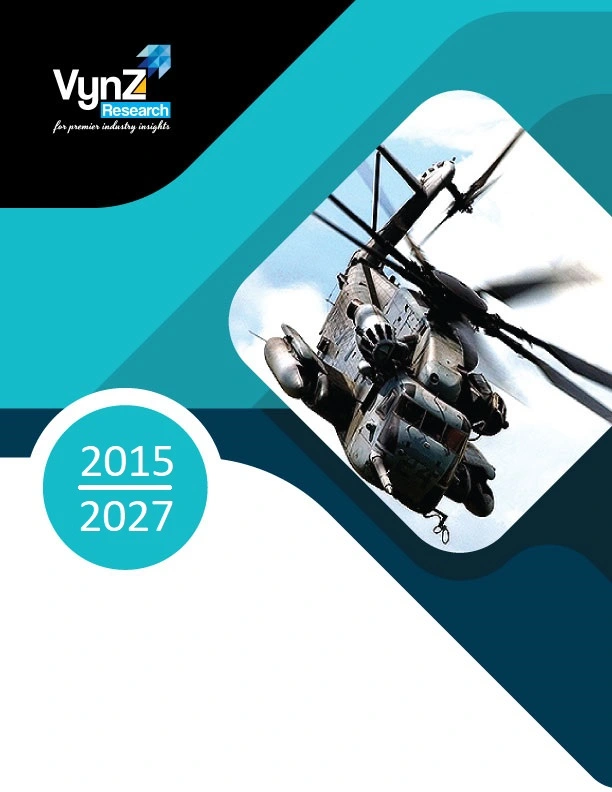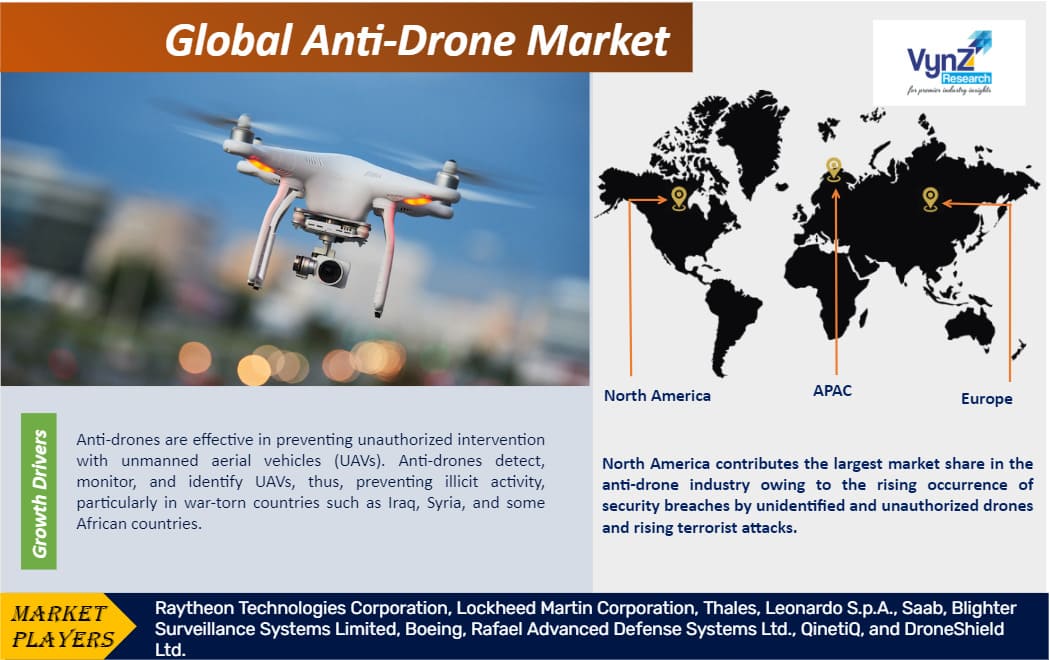| Status : Published | Published On : Dec, 2023 | Report Code : VRAD12013 | Industry : Aerospace and Defense | Available Format :

|
Page : 187 |

Global Anti-Drone Market – Analysis and Forecast (2025-2030)
Industry Insights By Technology (laser systems, kinetic systems, and electronic systems), By Platform Type (UAV-based, handheld, and ground-based), By Application (detection and detection & disruption), By End Use (military and defense, commercial, and homeland security)
Industry Overview
The Global Anti-Drone market size is anticipated to grow from USD 1.4 billion in 2023 to USD 7.5 billion by 2030, registering a 29% CAGR during the forecast period 2025-2030. An anti-drone system can be customised as per the demand and requirements of customers and includes several equipment and solutions. It is used to minimize security breaches in homes, prisons, businesses, public spaces, government structures, workplaces, industrial facilities, airways, border security, critical infrastructure, and military sites. The use of FBG (Fiber Bragg Grating) technology in multiple sectors for several applications is anticipated to drive the anti-drone market. The increased demand from the commercial sector, businesses that provide quick package delivery, and military organizations that conduct operations against terrorists are all having a positive impact on the anti-drone market. Unmanned aerial vehicles (UAVs) of all varieties are now used more frequently than ever before, thereby spurring the market demand for the anti-drone industry.

There is increased development of drone and anti-drone technology, however, the anti-drone industry is still in its nascent stage and have numerous opportunities to develop anti-drone technologies and concepts which can be used in several industries such as the defense, and e-commerce sector.
Anti-Drone Market Segmentation
Insight by Technology
On the basis of technology, the global anti-drone market is categorized into laser systems, kinetic systems, and electronic systems. Electronic systems dominate the anti-drone industry during the forecast period. The electronic equipment deployed in anti-drone applications includes electro-optical systems, GNSS jammers, RF jammers, infrared sensor systems, and radar. The market is witnessing significant growth in electronic systems owing to a surge in public and private sector investment to develop electronic anti-drone systems.
Insight by Platform Type
On the basis of platform type, the global anti-drone market is segregated into UAV-based, handheld, and ground-based. The ground-based anti-drone technology will account for the largest market share during the forecast period owing to its wide accessibility along with its effectiveness to monitor and detect illicit activities will propel the market growth of the anti-drone industry.
Insight by Application
On the basis of application, the global anti-drone market is bifurcated into the detection and detection & disruption. The detection system is anticipated to have a high CAGR during the forecast period. The detection systems use several technologies to find and identify drones, such as radar reflectance, the appearance of a specific photon, and the resulting magnetic field, along with acoustic and electromagnetic emissions. These initiatives represent rising market demand as a result of the global rise in security breaches.
Insight by End Use
On the basis of end-user, the global anti-drone market is categorized into military and defense, commercial, and homeland security. The military and defense sector will dominate the anti-drone market due to increased terrorist and illicit activities globally such as smuggling, border crossings, piracy, spying, etc. The rising awareness and robust advancement of low-cost drones will fuel market expansion. Research and development in the defense sector are expected to rise as armed forces are deploying anti-drone technologies to deter invaders. These factors are expected to have a substantial impact on military and defense sector growth.
Global Anti-Drone Market Report Coverage
|
Report Metric |
Details |
|
Historical Period |
2018 - 2023 |
|
Base Year Considered |
2024 |
|
Forecast Period |
2025 - 2030 |
|
Market Size in 2024 |
U.S.D. 1.4 Billion |
|
Revenue Forecast in 2030 |
U.S.D. 7.5 Billion |
|
Growth Rate |
29% |
|
Segments Covered in the Report |
By Technology, By Platform Type, By Application, and By End-Use |
|
Report Scope |
Market Trends, Drivers, and Restraints; Revenue Estimation and Forecast; Segmentation Analysis; Impact of COVID-19; Companies’ Strategic Developments; Market Share Analysis of Key Players; Company Profiling |
|
Regions Covered in the Report |
North America, Europe, Asia-Pacific, Middle East, and the Rest of the World |
Industry Dynamics
Anti-Drone Market Growth Drivers
Anti-drones are effective in preventing unauthorized intervention with unmanned aerial vehicles (UAVs). Anti-drones detect, monitor, and identify UAVs, thus, preventing illicit activity, particularly in war-torn countries such as Iraq, Syria, and some African countries. These are mostly used by the military and defense industry. Thus, the rise in the number of security breaches caused by unauthorized drones is anticipated to have an impact on the anti-drone market's expansion. Moreover, an upsurge in investments in laser-based anti-drone systems along with increased adoption of drones for professional and leisure purposes will accelerate the market development of the anti-drone systems. Additionally, the increasing government spending on the expansion of the aerospace and defense infrastructure increased concern about the potential security threat of drones, increased use of anti-drone systems and technologies as well as the increasing use of drones for terrorism and other illegal operations globally are both expected to fuel the market growth of the anti-drone industry. Nevertheless, the anti-drone market has seen significant market growth owing to the burgeoning use of high-energy lasers and high-power microwave systems, the rising use of artificial intelligence in anti-drone systems, and blockchain technology.
Anti-Drone Market Challenges
The huge R&D costs owing to the adoption of lasers and other costly technologies will lead to high upfront capital, thereby small and medium-sized players are not able to develop and implement anti-drone systems. Moreover, UAVs are easily detectable by an anti-drone, but it is uncertain how they will crash, raising concerns for public safety. This has prompted governments all over the world to enact stringent anti-drone legislation and regulations.
Anti-Drone Market Opportunities
The market for the anti-drone industry provides numerous opportunities to the market participants owing to the below-mentioned reasons:
• Surge in demand for anti-drone systems in military and defense applications
• Increased need to develop versatile and scalable anti-drone systems
• Technological advancement in Drone Technology and the Development of Compact Drones
• Upsurge in Private Investment
Anti-Drone Market Geographic Overview
North America contributes the largest market share in the anti-drone industry owing to the rising occurrence of security breaches by unidentified and unauthorized drones and rising terrorist attacks. The increased adoption of drone technology by the aviation industry, rising investment by the US Department of Defense (DoD) to develop and deploy counter-drone technologies along with increased processing of several UAS technologies at airports by the Federal Aviation Administration (FAA) will surge the market demand for anti-drones during the forecast period.
APAC has emerged as a key global hub for significant investments and has the market potential for company growth. In the Asia Pacific area, the necessity for anti-drone systems to kill or take control of rogue or hazardous drones tends to grow as a result of rising security, safety awareness, and rising political tensions among various nations.
Anti-Drone Market Competitive Insight
The industry players that are operating in the anti-drone technology are emphasizing enhancing the range, size, accuracy, and other physical and functional parameters so have a competitive advantage in the global anti-drone market landscape. They are spending a significant amount of money by testing several prototypes and enhancing the design of their anti-drone systems. These industry players are emphasizing developing anti-drone technologies which have the capability of tracking, detecting, jamming, and destroying rogue drones. The main consumers of anti-drone technologies are government agencies, businesses, and the armed forces.
Lockheed Martin has been providing the U.S. military and allies with cutting-edge autonomous systems to support clients' most challenging operations. They are fusing commercial best practices along with technological know-how to provide cutting-edge autonomy capabilities to the military industry quickly and affordably through smart investments and unconventional alliances. A Lockheed Martin Q-53 radar proved that it is capable of handling the difficult task of finding drones. In a demonstration, the radar system was modified to offer both air surveillance and target acquisition for counterfire. Multiple unmanned aerial systems were found and tracked by the Q-53 system, which then relayed this information to the command-and-control post.
In order to revolutionize unmanned aviation and urban air mobility, Thales, a significant global player in the aviation industry, is bringing to the drone ecosystem its special blend of domain experience. Thales is redefining what is possible in this UAS market, from flight avionics to UAV system design and operations, wireless communications systems, digital identity and cybersecurity, positioning and navigation supporting satellite systems. The Thales C-UAS EagleShield suite is an integrated nano, micro, mini, and small drone countermeasures solution to secure and protect civil and military sites, including stadiums, airports, critical infrastructures (such as oil and gas), large cities, high-profile events (such as Bastille Day, the G7, the Olympic Games, and the World Cup), and military airfields.
Some of the major players in the anti-drone industry include Raytheon Technologies Corporation, Lockheed Martin Corporation, Thales, Leonardo S.p.A., Saab, Blighter Surveillance Systems Limited, Boeing, Rafael Advanced Defense Systems Ltd., QinetiQ, and DroneShield Ltd.
Recent Development by Key Players
The aerospace company Raytheon UK announced plans to open an advanced laser integration facility in Livingston, Scotland, starting the following year. Defense high-energy laser weapon system testing, deployment, and maintenance will be the key priorities of the facility. The decision was made as the need for anti-drone technology continued to rise as a result of new threats like the continuing Russia-Ukraine war.
In order to create a sophisticated manned-unmanned teaming capability using F-35 fighter jets and combat drones, Lockheed Martin will spend $100 million of its own money. Under the " Project Carrera" plan, an F-35 would cooperate with " a network" of Speed, Racer drones to carry out various tasks. To enable fighter pilots to control drones in flight, it will concentrate on deploying artificial intelligence (AI), upgrading the F-35s, and creating cutting-edge communications technologies. As part of the research, Lockheed will also figure out how to build trust between human operators and the AI-controlling unmanned systems.
The Anti Drone Market Report offers a comprehensive market segmentation analysis along with an estimation for the forecast period 2025–2030.
Segments Covered in the Report
- By Technology
- Kinetic Systems
- Electronic Systems
- By Platform Type
- UAV-based
- Handheld
- Ground-Based
- By Application
- Detection
- Detection & Disruption
- By End-Use
- Military and Defense
- Commercial
- Homeland Security
Region Covered in the Report
- North America
- U.S.
- Canada
- Mexico
- Europe
- Germany
- U.K.
- France
- Italy
- Spain
- Russia
- Rest of Europe
- Asia-Pacific (APAC)
- China
- Japan
- India
- South Korea
- Rest of Asia-Pacific
- Rest of the World (RoW)
- Brazil
- Saudi Arabia
- South Africa
- U.A.E.
- Other Countries
.png)
Frequently Asked Questions
Purchase Options
Latest Report
Research Methodology
- Desk Research / Pilot Interviews
- Build Market Size Model
- Research and Analysis
- Final Deliverabvle
Connect With Our Sales Team
- Toll-Free: 1 888 253 3960
- Phone: +91 9960 288 381
- Email: enquiry@vynzresearch.com
Anti-Drone Market
